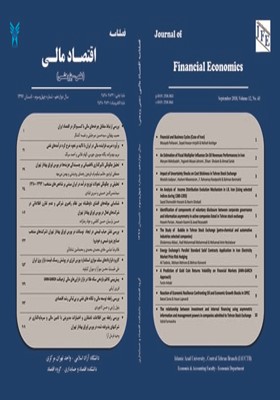پیشبینی تلاطم بازدهی سکه طلا در بازار داراییهای مالی ) رهیافت ANN-GARCH)
محورهای موضوعی : اقتصاد مالی
1 - استادیار دانشکده اقتصاد و حسابداری دانشگاه آزاد اسلامی، واحد تهران مرکزی، تهران، ایران.
کلید واژه: واژههای کلیدی: بازارهای مالی, تلاطم بازدهی, سکه طلا, پیشبینی. طبقه بندی JEL : G17, Q47,
چکیده مقاله :
پیش بینی تلاطم یکی از مهمترین موضوعات مورد مطالعه در بازارهای مالی دنیا است. تلاطم به عنوان یک عامل مؤثر در تعیین ریسک سرمایه گذاری، می تواند نقش مهمی در تصمیم گیری سرمایه گذاران ایفا کند. یک تخمین مناسب از تلاطم قیمت طلا یا دارایی های مالی همچون سکه طلا در یک دورة سرمایه گذاری نقطة آغازین بسیار مهمی در کنترل ریسک سرمایه گذاری است. هدف از تدوین این پژوهش مطالعه و پیشبینی تلاطم در بازدهی قیمت نقدی سکه طلا در ایران به روش ANN-GARCH است. در این پژوهش با استفاده از دادههای روزانه در فاصله زمانی 1388 تا 1395 این موضوع بررسی و نتایج نشان می دهد لحاظ تلاطم بازارهای مالی دیگر ازقبیل نوسانات نرخ ارز، تغییر قیمت نفت و تغییر شاخص قیمت سهام در بورس باعث بهبود توانایی پیش بینی مدل برآوردی می شود. استفاده از اطلاعات بازارهای موازی و نیز افزایش دوره پیش بینی میتواند نتایج بهتری در تبیین موضوع حاصل کند. One of the main topics to study is the prediction of volatility in financial markets. Volatility as an effective factor in the determination of the risk of investment plays a key role in the decisions of investors. A proper estimation of the volatility of gold prices or financial assets such as gold coin over the investment period is an important starting point for controlling the risk of investment. Predicting the volatility of the cash price return of gold coins with the use of ANN-GARCH is the aim of this study. This issue has been investigated by the daily data from 2009 to 2016. The results show that using the volatility of other financial markets such as exchange rate, oil price, and stock fluctuations, improves the ability to predict the model and the use of parallel market information; moreover, an increase in the forecast period can create better results in this terms.
1) سعیدی، علی، علیمحمدی، شهریار(1393)،" بررسی عوامل مؤثر بر تغییرات قیمت قراردادهای آتی در بورس کالای ایران"- فصلنامه مهندسی مالی و مدیریت اوراق بهادار، دوره 5، شماره 20
2) کشاورز حداد، غلامرضا ، حیرانی، مهرداد -1393- "برآورد ارزش در معرض ریسک با وجود ساختار وابستگی در بازدهی بازارهای مالی:رهیافت توابع کاپولا"- مجله تحقیقات اقتصادی- دوره 49، شماره 4، زمستان 1393، صفحه 869-902
3) Baillie, R., Bollerslev, T., Mikkelsen, H., 1996. Fractionally integrated generalized autoregressive conditional heteroskedasticity. J. Econ. 74, 3–30.
4) Baillie, R., Bollerslev, T., Mikkelsen, H., 1996. Fractionally integrated generalized autoregressive conditional heteroskedasticity. J. Econ. 74, 3–30.
5) Bollerslev, T., 1986. Generalized autoregressive conditional heteroskedasticity. J. Econ. 31,307–327.
6) Boyacioglu, M. A., & Avci, D. (2010). An adaptive network-based fuzzy inference system (ANFIS) for the prediction of stock market return: the case of the Istanbul stock exchange. Expert Systems with Applications, 37(12), 7908–7912.
7) Components Combining, neural networks and GARCH. Research in International Business and Finance.
8) Creti, A., Joëts, M., & Mignon, V. (2013). On the links between stock and commodity markets’ volatility. Energy Economics, 37, 16–28.
9) Dahl, C.M., Iglesias, E.M., 2009. Volatility spill-overs in commodity spot prices: new empirical results. Econ. Model. 26, 601–607.
10) Davidson, J., 2004.Moment andmemory proprieties of linear conditional heteroscedasticity models, and a newmodel. J. Bus. Econ. Stat. 22, 16–29.
11) Domanski, D., Heath, A., 2007. Financial investors and commodity markets. BIS Q. Rev. 53–67.
12) Dwyer, A., Gardner, G.,Williams, T., 2011. Global commoditymarkets—price volatility and financialisation. Reserve Bank of Australia Bulletin. 49–57 (June).
13) Elder, J., Serletis, A., 2008. Long memory in energy futures prices. Rev. Financ. Econ. 17, 146–155.
14) Engle, R.F., 1982. Autoregressive conditional heteroscedasticity with estimates of the variance of UK inflation. Econometrica 50, 987–1008.
15) Engle, R.F., 1982. Autoregressive conditional heteroscedasticity with estimates of the variance of UK inflation. Econometrica 50, 987–1008.
16) Engle, R.F., Bollerslev, T., 1986. Modelling the persistence of conditional variances. Econ. Rev. 5, 1–50.
17) Engle, R.F., Bollerslev, T., 1986. Modelling the persistence of conditional variances. Econ. Rev. 5, 1–50.
18) Geweke, J., Porter-Hudak, S., 1983. The estimation and application of long-memory time series models. J. Time Ser. Anal. 4, 221–238.
19) Giot, P., Laurent, S., 2003. Market risk in commodity markets: a VaR approach. Energy Econ. 25, 437–457.
20) Hammoudeh, S., Dibooglu, S., Aleisa, E., 2004. Relationships among US oil prices and oil industry equity indices. Int. Rev. Econ. Financ. 13 (3), 427–453.
21) Hammoudeh, S., Yuan, Y., 2008. Metal volatility in presence of oil and interest rate shocks. Energy Econ. 30, 606–620.
22) Hammoudeh, S., Yuan, Y., McAleer, M., Thompson, M., 2010. Precious metals-exchangerate volatility transmissions and hedging strategies. Int. Rev. Econ. Financ. 20,633–647.
23) Nelson, D.B., 1991. Conditional heteroscedasticity in asset returns: a new approach. Econometrica 59, 347–370.
24) Trück, S., & Liang, K. (2012). Modelling and forecasting volatility in the gold market. International Journal of Banking and Finance, 9(1), 3.
25) Tully, E., & Lucey, B. M. (2007). A power GARCH examination of the gold market. Research in International Business and Finance, 21(2), 316–325.
26) Vortelinos, D. I. (2015). Forecasting realized volatility: HAR against Principal
یادداشتها

